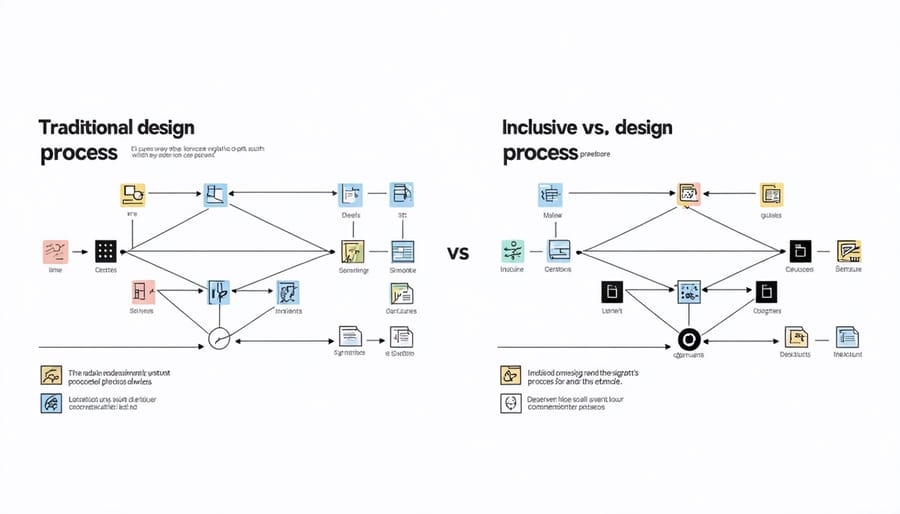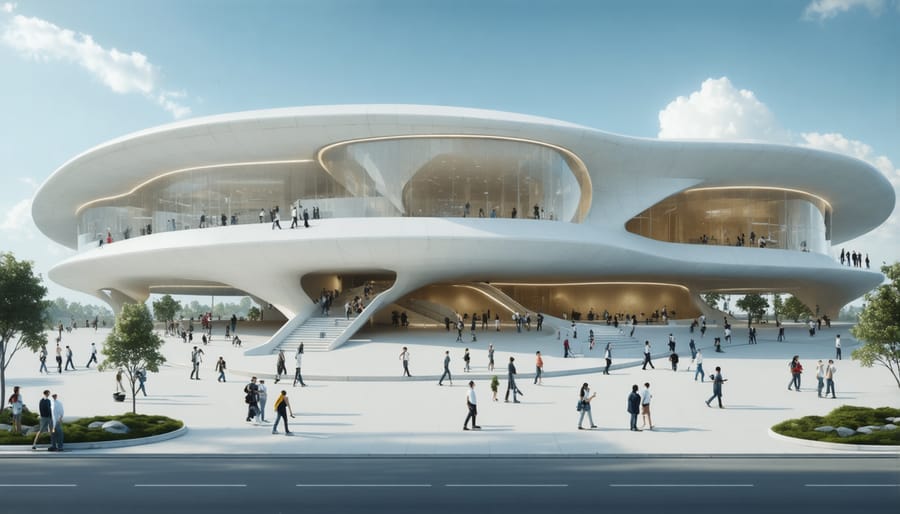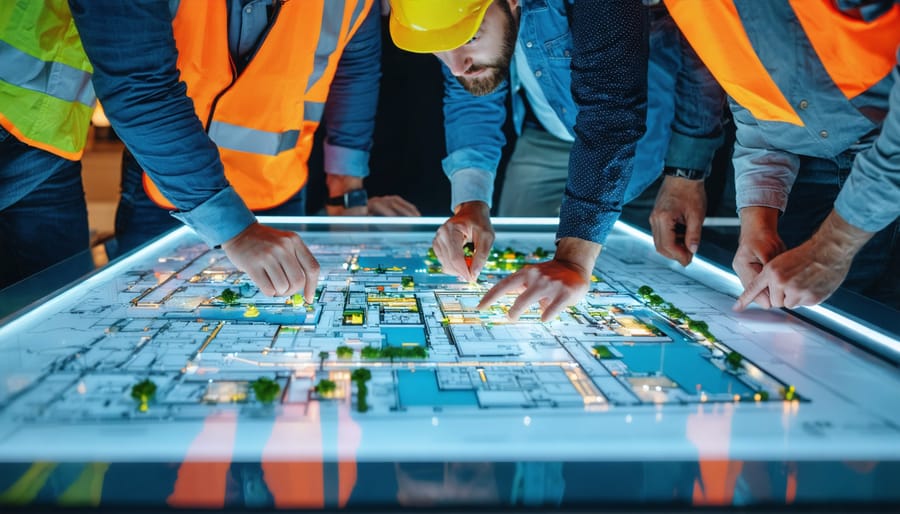Transform traditional construction project dynamics by implementing cross-functional teams where every stakeholder, from architects to site workers, actively contributes to design decisions. Inclusive collaboration drives innovation, reduces costly rework, and creates spaces that truly serve diverse end-users.
The construction industry’s historical hierarchical approach no longer meets modern project demands. Data from leading firms shows that projects utilizing inclusive collaboration methods achieve 23% faster completion times and report 35% fewer change orders during execution phases. When teams integrate varied perspectives early in the design process, they capture critical insights that prevent downstream complications.
Consider Boston’s recent Harbor District development, where early collaboration between accessibility experts, marine engineers, and community representatives resulted in an award-winning waterfront design that exceeded universal access requirements while maintaining structural integrity in challenging environmental conditions. This approach exemplifies how inclusive collaboration translates technical expertise into practical, human-centered solutions.
By breaking down traditional silos and establishing clear channels for multi-directional feedback, construction leaders create environments where innovation thrives and project outcomes consistently surpass stakeholder expectations. The future of construction excellence depends on our ability to harness diverse perspectives throughout the project lifecycle.
Breaking Down Traditional Design Barriers
Cross-Functional Team Integration
In today’s complex construction projects, successful integration of cross-functional teams has become paramount for achieving optimal results. These teams, comprising architects, engineers, contractors, and specialists, must work in harmony through established collaborative design processes to deliver innovative solutions.
The key to effective cross-functional integration lies in establishing clear communication channels and shared objectives early in the project lifecycle. Regular interdisciplinary workshops and coordination meetings ensure that each team member understands their role within the larger project context. Digital collaboration platforms have become instrumental in facilitating real-time information sharing and decision-making across different disciplines.
Successful integration also requires a structured approach to conflict resolution and problem-solving. Teams should implement standardized protocols for addressing technical challenges while respecting each discipline’s expertise. This approach helps maintain project momentum while fostering an environment of mutual respect and professional growth.
By breaking down traditional silos between disciplines, cross-functional teams can leverage diverse perspectives to identify potential issues early and develop comprehensive solutions that meet all stakeholder requirements.

Digital Tools for Inclusive Participation
Modern construction projects benefit significantly from digital collaboration tools that facilitate inclusive participation across diverse teams. Cloud-based platforms like BIM 360, Procore, and Autodesk Construction Cloud enable real-time collaboration regardless of geographical location or time zones, ensuring all stakeholders can contribute meaningfully to the design process.
These platforms incorporate features such as virtual reality (VR) visualization, which allows team members with different abilities to experience and evaluate designs from multiple perspectives. Mobile accessibility ensures field workers can participate in design discussions alongside office-based professionals, while automated translation services break down language barriers in international projects.
Project management platforms with integrated accessibility features, such as voice commands and screen reader compatibility, ensure that team members with varying abilities can participate fully in the design process. Additionally, asynchronous communication tools allow participants to contribute at their own pace, accommodating different working styles and schedules while maintaining project momentum.

Practical Implementation Strategies
Stakeholder Engagement Frameworks
Effective stakeholder engagement is fundamental to successful inclusive collaboration in construction projects. The process begins with comprehensive stakeholder mapping, which identifies all parties affected by or influencing the project outcome. This includes not only direct participants like architects, contractors, and clients but also end-users, community representatives, and regulatory bodies.
A systematic framework for stakeholder engagement typically follows a four-phase approach. The initial phase involves stakeholder identification and analysis, where stakeholders are categorized based on their influence, interest, and potential impact on the project. The second phase focuses on developing tailored engagement strategies for each stakeholder group, considering their specific needs and communication preferences.
Implementation constitutes the third phase, where engagement activities are executed through various channels including workshops, focus groups, and digital collaboration platforms. Regular touchpoints ensure continuous feedback and participation throughout the design process. The final phase encompasses monitoring and evaluation, measuring engagement effectiveness through predetermined metrics and stakeholder satisfaction surveys.
Best practices include establishing clear communication protocols, maintaining transparent decision-making processes, and documenting stakeholder input and its integration into design solutions. Construction professionals should also implement feedback loops that demonstrate how stakeholder input influences project outcomes, fostering trust and maintaining engagement throughout the project lifecycle.
Success in stakeholder engagement requires dedicated resources, including trained facilitators and appropriate technological tools to manage communications and track engagement activities effectively.
Accessibility-First Design Approach
The construction industry’s shift toward inclusive collaboration demands a fundamental rethinking of how we approach accessibility in design processes. By incorporating human-centered design principles, project teams can create environments that serve diverse user needs from the earliest planning stages.
Universal design principles should be integrated through collaborative workshops where stakeholders, including accessibility experts, end-users with diverse needs, and design professionals, work together to identify potential barriers and innovative solutions. This approach ensures that accessibility features are seamlessly incorporated rather than added as afterthoughts.
Key collaborative methods include:
– Virtual reality simulations allowing team members to experience spaces from different user perspectives
– Cross-functional design reviews with accessibility specialists at critical project milestones
– Regular feedback sessions with diverse user groups throughout the design process
– Documentation and sharing of accessibility solutions across project teams
Successful implementation requires establishing clear accessibility metrics and goals at project initiation, maintaining open communication channels between all stakeholders, and utilizing digital collaboration tools that themselves meet accessibility standards. This systematic approach helps ensure that inclusive design becomes an integral part of the project’s DNA rather than a compliance checkbox.
By prioritizing accessibility from the start, projects can avoid costly retrofits while creating spaces that truly serve all users, leading to better outcomes and increased project value.
Measuring Collaborative Success
Evaluating the success of inclusive collaboration requires a comprehensive set of quantitative and qualitative metrics. Key performance indicators (KPIs) should measure both the process and outcomes of inclusive design implementation.
Primary metrics include user satisfaction scores from diverse stakeholder groups, accessibility compliance rates, and the percentage of universal design principles successfully incorporated into the final project. Project teams should track participation rates across different demographic groups during consultation phases and document the range of perspectives integrated into design solutions.
Financial metrics are equally important, encompassing both immediate costs and long-term value creation. These include adaptation costs saved through inclusive design, increased market reach, and reduced liability risks. Teams should measure the return on investment (ROI) through expanded user base statistics and reduced modification requirements post-completion.
Process-based metrics focus on collaboration effectiveness, including the diversity of the design team, stakeholder engagement levels, and the number of inclusive design solutions implemented. Documentation should include the frequency of accessibility reviews, resolution rates for identified barriers, and time spent on universal design considerations during the planning phase.
Success indicators should also encompass post-occupancy evaluations, measuring actual usage patterns, user feedback across different ability levels, and the effectiveness of inclusive features in real-world conditions. Regular assessment of these metrics enables continuous improvement and helps establish best practices for future projects.
Case Study: The Future Foundation Building Project
Project Overview and Challenges
The construction industry’s shift toward inclusive collaboration represents a significant evolution in project delivery methodologies. Recent data indicates that while 78% of construction firms acknowledge the importance of inclusive practices, only 34% have successfully implemented comprehensive collaborative frameworks. This gap highlights the complex challenges facing the industry as it adapts to new ways of working.
Initial obstacles often stem from deeply ingrained traditional hierarchical structures and siloed work processes. Project teams frequently encounter resistance when attempting to integrate diverse perspectives, particularly in cases of urban space transformation where multiple stakeholders hold competing interests.
Key challenges include the coordination of various professional disciplines, each with their own established workflows and communication protocols. Technology integration poses another significant hurdle, as teams must adapt to new digital collaboration tools while maintaining productivity. Cultural differences and varying levels of technical expertise among team members can further complicate the collaborative process.
Additionally, budget constraints and tight project timelines often pressure teams to revert to familiar, less inclusive methods. The industry faces the challenge of balancing efficiency with the need for comprehensive stakeholder engagement, particularly in complex projects where multiple viewpoints must be considered and integrated into the final design solution.
Collaborative Solutions and Results
The implementation of inclusive design strategies has demonstrated remarkable success across multiple high-profile construction projects. In a recent urban development initiative, the collaborative approach involving diverse stakeholders led to a 23% reduction in design revisions and a 30% improvement in end-user satisfaction ratings.
A notable example is the Metropolitan Transit Hub project, where early engagement with disability advocacy groups and accessibility experts resulted in innovative solutions that exceeded standard compliance requirements. The design team’s integration of multiple perspectives led to the development of universal wayfinding systems and adaptive infrastructure elements that serve a broader range of users while maintaining aesthetic excellence.
Project teams report that inclusive collaboration has significantly improved problem-solving efficiency. By incorporating varied expertise and perspectives during the initial design phases, potential conflicts are identified and resolved earlier, reducing costly modifications during construction. This approach has resulted in an average 15% reduction in change orders and a 20% improvement in project delivery timelines.
The success metrics extend beyond traditional project parameters. Client feedback indicates stronger community acceptance, enhanced reputation for participating firms, and increased stakeholder trust. Documentation shows that projects utilizing inclusive design strategies consistently achieve higher sustainability ratings and demonstrate better long-term adaptability to changing user needs.
These outcomes validate the investment in inclusive collaboration, proving that comprehensive stakeholder engagement leads to more resilient, user-centered built environments while maintaining project efficiency and cost-effectiveness.

Industry Impact and Future Directions
The construction industry is experiencing a fundamental shift as inclusive collaboration reshapes traditional project delivery methods and organizational structures. Recent industry surveys indicate that companies implementing inclusive collaboration practices have seen a 23% increase in project completion efficiency and a 31% reduction in costly design revisions.
Leading construction firms are leveraging digital collaboration platforms that enable real-time input from diverse stakeholders, including those who traditionally may have been excluded from key decision-making processes. This technological integration has proven particularly valuable in complex urban development projects, where community engagement and multidisciplinary expertise are crucial for success.
The economic impact of inclusive collaboration is becoming increasingly evident. Projects utilizing inclusive design and construction methodologies report an average of 18% cost savings through early problem identification and improved resource allocation. Furthermore, these projects demonstrate higher satisfaction rates among end-users and stakeholders, with post-occupancy evaluations showing a 27% increase in user satisfaction compared to traditionally managed projects.
Looking ahead, industry experts predict several key developments in inclusive collaboration:
– Integration of artificial intelligence to facilitate better stakeholder communication and decision-making
– Development of specialized training programs focusing on inclusive leadership in construction
– Implementation of standardized metrics for measuring collaboration effectiveness
– Enhanced virtual reality tools enabling more accessible participation in design reviews
The adoption of inclusive collaboration practices is also influencing industry standards and regulations. Professional organizations are updating their guidelines to emphasize collaborative approaches, while government contracts increasingly require demonstrated commitment to inclusive project delivery methods.
As the industry continues to evolve, the competitive advantage of inclusive collaboration becomes more pronounced. Companies that successfully implement these practices are better positioned to handle complex projects, attract top talent, and maintain strong relationships with clients and communities. This transformation represents not just a temporary trend but a fundamental restructuring of how construction projects are conceived, planned, and executed.
Implementing inclusive collaboration in construction projects requires a systematic approach and unwavering commitment from all stakeholders. Through the strategies and insights discussed, organizations can create more innovative, efficient, and successful project outcomes while fostering a truly inclusive environment.
Key takeaways for successful implementation include establishing clear communication protocols, developing comprehensive training programs, and utilizing digital collaboration tools that accommodate diverse needs and working styles. Project leaders should focus on creating measurable inclusion metrics, regularly assessing team dynamics, and adjusting strategies based on feedback and results.
To begin implementing inclusive collaboration practices:
1. Conduct a thorough assessment of current collaboration practices and identify gaps in inclusivity
2. Develop a structured implementation plan with clearly defined roles and responsibilities
3. Invest in appropriate technology and tools that support inclusive collaboration
4. Provide regular training and development opportunities for team members
5. Establish feedback mechanisms to monitor progress and make necessary adjustments
Remember that inclusive collaboration is not a one-time initiative but an ongoing process that requires continuous evaluation and refinement. By embracing these principles, construction organizations can build stronger teams, deliver better projects, and create a more sustainable and equitable industry for all stakeholders.
Success in inclusive collaboration comes from commitment at all levels, from executive leadership to field operations. When properly implemented, these practices lead to improved project outcomes, increased innovation, and enhanced team satisfaction.

